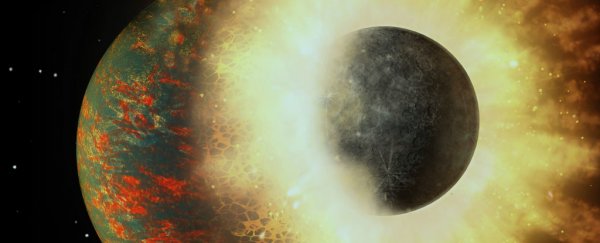Life on Earth may be the result of a gigantic collision between Earth and another planet some 4.4 billion years ago, according to a new study.
Researchers think that such a planetary smash-up could explain how carbon – which is necessary for carbon-based life forms like us to exist – came to be on the planet's mantle and surface, solving a long-standing evolutionary mystery.
When Earth was very young, it was also extremely hot, due to extreme amounts of volcanic activity that made the planet a large, molten mass.
One of the problems with explaining how life on Earth could have developed, then, is that any carbon on the planet during this hellish infancy would have boiled away in such a heated environment.
But geologists from Rice University are now suggesting one way that carbon – and, therefore, you and me – got around this.
A collision with a Mercury-like planet after Earth had cooled off could have effectively delivered the carbon necessary for future life on the planet to evolve – with Earth absorbing this mystery planet's carbon load.
Such a hypothesis not only accounts for how carbon on Earth's surface existed after the planet's molten beginnings, but also how the element didn't become fused within Earth's core, where life would also be unable to develop.
"The challenge is to explain the origin of the volatile elements like carbon that remain outside the core in the mantle portion of our planet," says geologist Rajdeep Dasgupta.
"[E]ven if carbon did not vaporise into space when the planet was largely molten, it would end up in the metallic core of our planet, because the iron-rich alloys there have a strong affinity for carbon."
The notion that Earth's life-giving carbon originally came from somewhere else isn't new. The 'late veneer hypothesis' suggests that some of the chemicals found on Earth today originated from elsewhere in space, and may have been deposited on our planet via meteorite impacts.
"One popular idea has been that volatile elements like carbon, sulphur, nitrogen, and hydrogen were added after Earth's core finished forming," explains former Rice geochemist Yuan Li, now with the Chinese Academy of Sciences.
"Any of those elements that fell to Earth in meteorites and comets more than about 100 million years after the Solar System formed could have avoided the intense heat of the magma ocean that covered Earth up to that point."
But while the late veneer hypothesis sounds plausible, it has its shortcomings – such as failing to explain how random and isolated meteorite collisions could produce such a diverse spread of elements like carbon throughout Earth's mantle, which makes up around two-thirds of the planet's mass.
"The problem with that idea is that while it can account for the abundance of many of these elements, there are no known meteorites that would produce the ratio of volatile elements in the silicate portion of our planet," says Li.
Conducting high-pressure and high-temperature experiments in the lab with hydraulic equipment, the researchers looked to see what kinds of chemicals and conditions might lead to the elemental ratio seen in Earth's mantle.
"We thought we definitely needed to break away from the conventional core composition of just iron and nickel and carbon," says Dasgupta. "So we began exploring very sulphur-rich and silicon-rich alloys, in part because the core of Mars is thought to be sulphur-rich and the core of Mercury is thought to be relatively silicon-rich."
The team found that, in the event of a hypothetical collision between Earth and another mass, carbon could remain in Earth's mantle – and not be wholly absorbed into its iron core – if the other mass contained an iron alloy in its core that was rich in either silicon or sulphur.
"One scenario that explains the carbon-to-sulphur ratio and carbon abundance is that an embryonic planet like Mercury, which had already formed a silicon-rich core, collided with and was absorbed by Earth," says Dasgupta.
"Because it's a massive body, the dynamics could work in a way that the core of that planet would go directly to the core of our planet, and the carbon-rich mantle would mix with Earth's mantle."
In other words, the chemical makeup of Earth's life-supporting geology today can be explained if our planet happened to 'eat' a smaller, Mercury-like planet billions of years ago.
It's a heck of a hypothesis – and will no doubt receive considerable scrutiny from other scientists. For their part, the researchers acknowledge there's a lot more work to be done to reconcile other volatile elements, as they've only looked at carbon and sulphur so far.
But the ideas may also help us to understand better why life on other planets is so rare.
It could be that not only does a planet need the right positioning and temperature to support life – it may require a little help, in terms of things like random collisions in space, to give it the extra ingredients to really get things cooking.
The findings are reported in Nature Geoscience.
